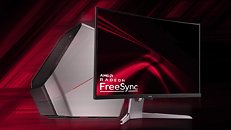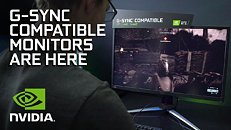Raevenlord
News Editor
- Joined
- Aug 12, 2016
- Messages
- 3,755 (1.18/day)
- Location
- Portugal
| System Name | The Ryzening |
|---|---|
| Processor | AMD Ryzen 9 5900X |
| Motherboard | MSI X570 MAG TOMAHAWK |
| Cooling | Lian Li Galahad 360mm AIO |
| Memory | 32 GB G.Skill Trident Z F4-3733 (4x 8 GB) |
| Video Card(s) | Gigabyte RTX 3070 Ti |
| Storage | Boot: Transcend MTE220S 2TB, Kintson A2000 1TB, Seagate Firewolf Pro 14 TB |
| Display(s) | Acer Nitro VG270UP (1440p 144 Hz IPS) |
| Case | Lian Li O11DX Dynamic White |
| Audio Device(s) | iFi Audio Zen DAC |
| Power Supply | Seasonic Focus+ 750 W |
| Mouse | Cooler Master Masterkeys Lite L |
| Keyboard | Cooler Master Masterkeys Lite L |
| Software | Windows 10 x64 |
In the wars of variable refresh rates, much ink has already been spilled regarding the open, AMD FreeSync approach and NVIDIA's proprietary G-Sync modules. The war started to give its first signs of abatement once NVIDIA seemed to throw in the towel by officially supporting VESA's VRR (Variable Refresh Rate) technology on its graphics cards, basically opening the way for NVIDIA graphics cards to correctly operate with previously AMD FreeSync-branded monitors. Now, it seems one more step will be taken on that road which should be G-Sync's proprietary approach final whiff, since according to a report from TFT Central, confirmed by NVIDIA, the company will enable VRR support for next releases of monitors equipped with the company's G-Sync module. This will essentially enable AMD graphics cards to work with NVIDIA-branded G-Sync monitors.

This move will only work for future monitor releases, mind you - a firmware update which will be distributed amongst monitor makers will enable the next releases of G-Sync to support VESA's VRR standard. This will not, apparently, be happening with already-released G-Sync modules, whether carrying NVIDIA's first take on the technology, nor the v2 G-Sync modules. It's not a perfect solution, and current adapters of G-Sync are still locked-in to NVIDIA graphics cards for VRR support on their monitors. It is, however, a definite step forward. Or a step backwards from a proprietary, apparently unneeded technology - you can really look at it either way.


Whether or not this makes sense from a product standpoint will only be understood once pricing on future NVIDIA G-Sync monitors surfaces - but we are finding it a hard sell for monitor makers to invest much in the G-Sync module going forward, since there are no practical, user-observable differences aside final product cost.
View at TechPowerUp Main Site

This move will only work for future monitor releases, mind you - a firmware update which will be distributed amongst monitor makers will enable the next releases of G-Sync to support VESA's VRR standard. This will not, apparently, be happening with already-released G-Sync modules, whether carrying NVIDIA's first take on the technology, nor the v2 G-Sync modules. It's not a perfect solution, and current adapters of G-Sync are still locked-in to NVIDIA graphics cards for VRR support on their monitors. It is, however, a definite step forward. Or a step backwards from a proprietary, apparently unneeded technology - you can really look at it either way.


Whether or not this makes sense from a product standpoint will only be understood once pricing on future NVIDIA G-Sync monitors surfaces - but we are finding it a hard sell for monitor makers to invest much in the G-Sync module going forward, since there are no practical, user-observable differences aside final product cost.
View at TechPowerUp Main Site





